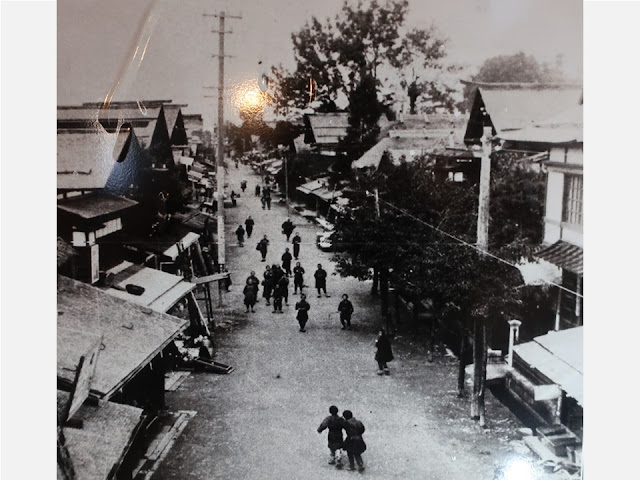Masuda is in Akita prefecture in Northern Japan. It is an inland town with heavy snowfalls, but it has flourished as a trading hub of agricultural products especially after the Meiji period (1868-1912). In the Taishou period (1912-1926), the mining business caused Masuda the prime time.
Although the mines were closed in the end
of the 20th century, luxurious merchant houses remain at the main
street. The area is designated as the Preservation District for Groups of
Traditional Buildings by Japanese government. The large houses which have a
fire-proof storage house in it characterize Masuda town. Some of them
have a living room in its storage house. The guide said the number of
visitors has been increasing since ten years ago.
The merchants spend thrift everyday lives,
however they spend a lot of money on the ceremonial day. The trait looks like
Ohmi merchants in Shiga prefecture which is a home town of many entrepreneurs.
Reference: Museums in Ohmi Gokasho (1)、近江・五個荘の資料館(1)
横手市にある増田は、農作物、養蚕物やタバコなどを扱う商業地で、特に明治以降に栄えました。ました。大正期からは銅などが採れる吉乃鉱山で賑わい、町の繁栄は最盛期を迎えました。2mを越える雪が積もる豪雪地帯です。
鉱山は20世紀末に閉山してしまいましたが、通りには豪勢な商家が並びます。重要伝統的建造物群保存地区に指定されています。座敷がある座敷蔵、内蔵がある家が50軒ほどあります。10年ほど前から観光客が増えているそうですよ。
商人達は質素倹約ですが、ハレの日は家に出張料理人を呼んで豪勢に過ごすことが多く、近江商人と似た気質があるようですね。普通の人々の楽しみ、というより、富豪の楽しみがたくさん見つかりました。
Ex hardware store “Ishihei”、旧石平金物店
The house is used as a tourist office and a souvenir shop.
麓の駅&増田観光物産センターとして活用されています。
If you stand at the entrance, you can see the long hallway to the end of the house. Every house which faces the main street has a land of 90m length. Let’s go inside.
通り(中七日町通り)から見ても、立派な商家ですが、奥行きが半端ないです。増田の区割りは奥行きが、なんと90(50間)mです。
The photo above is the view from the entrance hall. I’m happy if you can image how long the house is.
There is a business space behind the hall. The design of sliding partitions is similar to it of Kakunodate town which is also in Akita. There is a living space behind the business space.
玄関から見た通り庭。その長さをおわかり頂けますかねえ。
通りに面した、ミセに続いてチョウバがあります。ガラス戸の奥の間です。襖のデザインが、角館の商家と同じタイプの格子柄です。その奥が座敷になっています。
Behind the living space, there is a kitchen space without ceiling. It equips the well, so people didn’t need to go out to draw water in a snowy winter. Women gathered here probably. The inner storage house is behind the kitchen space.
座敷の先は、台所、ミズヤです。冬に外に出なくて良いように、家の中に井戸を掘りました。女性達はここに集まったのでしょうねえ。天井は貼っていません。その先に増田の特徴・内蔵の入口があります。
Wooden sleds are displayed. It’s a snowy region, isn’t it?
台所に、そりが付いた荷車がありました。雪国らしい展示品ですね。
The entrance door of the inner storage house. The craftsmen show off their skills to finish the lacquered surface. S. Yoshinaga (famous actress) stood in front of the door to create a JR’s poster. Let’s go inside.
内蔵は、正面の扉の黒漆の仕上げが職人の腕の見せ所だそうです。蔵の中に入ります。JRのCMで吉永小百合さんが立った場所にマークがあり、似たようなポーズで写真を撮れます。蔵の中に入りましょう。(JR東日本/2017年の大人の休日クラブ:https://www.jreast.co.jp/otona/tvcm/masuda.html)
The second floor is a storage of excellent tableware and so on. The first floor was a study room of the family head. There are many pillars. (I myself prefer an open space.)
蔵の二階が什器などの保管庫、一階は主人の居室として使われいたそうです。柱の数も多いです。でも、ここに居るのはどうでしょうかねえ。開放的な部屋の方がいいなあ、私は。
Behind the main building including the inner storage house, there is a garden and an outer storage house. The rear gate is behind it. How the family earned money to make such a luxurious house!
通り庭を出ると庭と外蔵があって、その先に裏門があります。良くこんなに富が集まったものだと感心するほど豪勢です。
Old photos are displayed on the wall of the hallway. There are many younger people and it is bustle.
通り庭に昔の写真などが展示されていました。この写真、若い人が多くて、活気があります。
It was only a hundred years ago. Children in Akita which is in the northern Japan also got suntan well. They were usually outside when they didn't help their family.
大正期。たった100年前です。秋田の子供も良く日焼けしていますね。
The street was a playground for the children back then.
道路は子ども達の遊び場でした。
The photo above shows the main street around a hundred years ago. Our lifestyle (house, transport, clothes and hairstyle) changed a lot.
100年で、世の中は大きく変わりましたね。
It is difficult in a snowy season, and it is also difficult in a snow melting one.
冬は降雪で大変ですが、雪が溶けている時もドロドロになって大変。
Ex Ishida Rikichi’s house、旧石田理吉家
It is a sole three-story house on the street, and there is a garden in front. The owner run a hospital but he donated the house to Yokote city and moved to the other prefecture. He is still a doctor, the staff said.
唯一の三階建てで、通りに面して店ではなく前庭があります。戦前は醸造業、その後、病院を営んでいました。今の当主は、この家を横手市に寄付し、別な県で病院を営んでおられるとのことです。
This is a wedding procession to Ishida house. The bride comes with marriage furniture and so on. Many spectators gather and they are excited. The practice is very rare nowadays. By the way, the bride’s house was next to Ishida’s house.
旧石田理吉家(金星)の嫁入りを見に来た人達。スゴイ熱気。楽しみなイベントだったのですね。今は、嫁入り道具がなくなってしまいました。お隣からの嫁入りだったそうです。
The three-story house was used for guests. There are two Japanese style rooms on the first floor. The Tokobashira pillar is very expensive. This building was built in 1937.
道路に近い三階建ての建物は、応接用です。一階は、和室が二部屋で書院造り。床柱など贅を尽くしています。昭和12年に建てられました。
There are also two rooms on the second floor, but one is Japanese style and the other is Western style. Kurogaki (Japanese persimmon) which was around 150 years old is used for Ranma.
二階は和室と洋室、欄間には一階と同じく樹齢150年クラスの貴重な黒柿が使われています。
There is a Japanese style hall on the third floor. It was used to watch the fireworks festival. Tsuguharu Fujita who was a popular painter stayed in this building. The wealthy family had special relationship with artists.
三階は大広間。花火を見るための部屋だそうです。藤田嗣治らも逗留したそうで世界が違いますね。
We can see the fire-proof storage house with living space from the first floor. The doors show how luxurious the house is. I was astonished by the money which Ishida Rikichi family made.
一階からは、明治14年(1881)に建てられた座敷蔵を見通せます。扉の重厚感から分かるとおり、こちらも贅を尽くしています。よくこれだけ富が集まったものだと思います。
There are many valuables such as tableware on the second floor of the storage house. The sake (alcohol) bottle with a lid attracted me.
蔵の二階には、数々の什器がありますが、この蓋付きとっくり、如何でしょうか。
The water channels run around the town.
町には水路も巡らされています。
Sake brewer “Hinomaru Jozo” stands at the south end of the preserved district which is 420m length from south to north. The tourist information center “Hotaru” is at opposite side. Both of them are designated building.
Each family used to have a family
business, so dozens of people including helpers
lived together. However, the house is too large for one family to live after they quit their business. Therefore, many families sold their houses. Among around fifty houses which
have inner fire-proof storages, only about ten families have lived there since
the early Showa period (1926-1989).
Whenever I visited a luxurious residence, I felt it is very difficult to keep. It’s not from jealousy, but a large house would not be conducive for comfortable living, I think.
南北420mの重要伝統的建造物群保存地区の南端に日の丸醸造です。その向かいには観光案内所のほたるがあります。何れも旧家です。
昔は、家内工業でいろいろな人が住んでいたのですが、家族だけで住むには大きすぎるとのこと。手放して行く人が多く、昭和初期から住んでいる方は内蔵のある約50軒の内、10軒ぐらいだそうです。
大きな家を維持し続けるのは、容易じゃないですね。やっかみではなく、毛利家しかり、鳩山家しかり、家族が住んで日々を楽しむのには大きすぎるようです。
Visited in October, 2020
Official website: https://www.city.yokote.lg.jp/kanko/page000107.html
(in Japanese), accessed in July, 2021
Previous post (Popular tourist spot in Akita and an exhibition room in a merchant
house):
Akita Kakunodate Tatetsu、角館と外町史料館たてつ
Next post (Museum
in Iwate which is the neighboring prefecture of Akita):
Folklore Museum in Michinoku Folklore Village、みちのく民俗村・民俗資料館

























Comments
Post a Comment